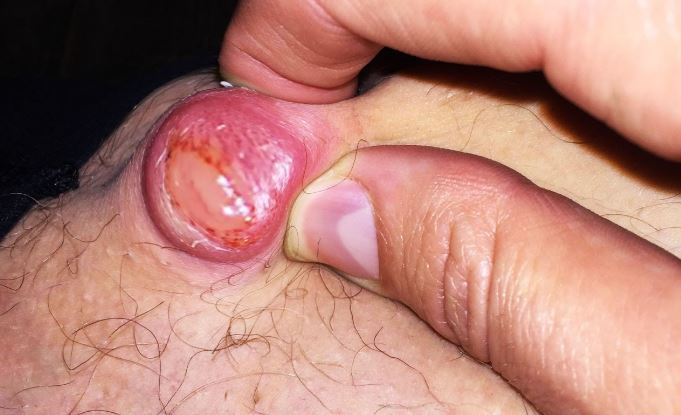A cyst on forehead is the most noticeable sign of an infection. For many, this can be a reason for embarrassment and reduced self-esteem. What then are the causes of the cyst on your face? What are the symptoms of a sebaceous cyst and what do you need to treat and get rid of the cyst? Please read through to get the answers to all this questions.
A sebaceous cyst are small noncancerous bumps beneath your skin. The cyst can appear on any part of the face, but it is more common for them to appear on face, neck and trunk. The cysts grows slowly and are often painless and seldom causes any health complication. If the cyst on your forehead appear to bother you, you could have it removed by your doctor. This will be mostly called for when the cyst gets painful, ruptures and or is infected.
Sebaceous cyst are also referred to as epidermoid cyst, but when careful examined, they seem to be differ a little. It is common for the cyst to arise from the glands that secrete oil matter (known as sebum) that secrete oily matter that lubricates hair and skin (sebaceous gland). The cyst are abnormalities in the body that may contain liquid or semi liquid materials.
Cyst on forehead symptoms
Cyst on forehead are clog of sebum. They feel like a small pea caught below the surface of the skin. The cyst maybe ringed by a small, red, white area. Although a cyst may look similar to a pimple, but are deeper in the skin and you should not pop it, until it develops a white head. Simple things such as warm compress can be helpful in soothing the cyst when trying to get rid of the sebaceous cyst on your forehead.

Therefore most cyst on your forehead will exhibit the following symptoms;
- Most will grow slowly
- There cyst are painless
- They are smooth to touch when you touch or feel them with your finger.
Picture, image of cysts on forehead
Pictures inserted here are meant to provide insightful visual aid to understand the cause of your symptoms. Find more in the post to understand the appearance of cysts on forehead even better.
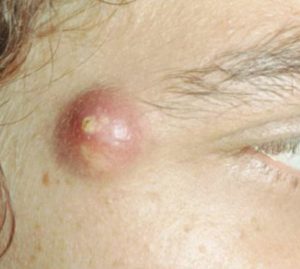
Causes of cysts on forehead
Sebaceous cyst occurs after hair follicle becomes swollen. The cyst originate from sebaceous gland that produce oil that lubricate the skin. There exist another type of cyst- Epidermoid cyst which originate from the surface of skin. When cells move deeper into skin instead of shedding off, they can multiply and lead to the formation of a cyst.
1. Acne Vulgaris
Acne is a long term skin infection. It is a common cause of spot in most of the people aged 12 and 25. Boys are more likely to contact acne compared to girls of the same age. It is common for acne to affect the face, but it may also affect the back, arms and legs and neck. According to the Journal of America Academy of Dermatology JAAD, acne is one of the most common skin disorders treated by dermatologists and other health care providers. It is common in adolescents and uncommon in adults. It is also possible for acne to appear in children.
The cause of acne is increased supply of sebum due to hormonal changes. This is more common in teenagers. Sebum is the oil secretion of the sebaceous glands that keeps the skin supple and smooth. The more the secretion the worse the acne gets.
The other cause of wild to moderate acne is when the pores on the surface of the skin blocks then traps a lot of deed cells and sebum. What follows is a white or black small pimple like cysts.
Acne is a normal skin condition and thus should not be a cause of worry. An antiseptic wash twice a day will be helpful in getting rid of the cyst on forehead. The available treatment option is for cleaning up the spots and preventing scarring. Depending on how severe the acne is the doctor may prescribe the best suited medicine. Topical creams, lotion and gel will be used to treat the cyst formed by acne.
2. Basal cell nevus
Basal cell nevus is a genetic condition. It affects the skin, endocrine system, nervous system and bones. The condition is also known as Gorlin syndrome or Nevoid basal cell carcinoma syndrome (NBCCS).
Basal cell nevus is the most common type of skin cancer in United States. Most common I people above 45year, and is usually due to prolonged exposure to sunlight.
The symptoms will include breast cancer, ovarian cancer and malignant brain tumor in children. The condition can be confirmed through genetic testing after which the treatment may be initiated. Treatment of basal cell nevus will be dependent on your symptoms. If you have cancer your dermatologist will be able to examine the stage and prescribe the best procedure for treatment. This will include;
- Radiation therapy
- Sugary for advance cancer
- Chemotherapy where oral medicine and injection will be used.
It is impossible to prevent the condition since it is a genetic condition, otherwise if you have the gene, you need to have a genetic counseling to reduce the chances of your children developing the syndrome in future.
3. Gardner’s syndrome
Gardener’s syndrome is a genetic condition. The condition is common with people with defect in the APC gene. This gene affects cell growth, it thus prevent the cells from dividing fast. This leads to abnormal tissue growth. The cause of this mutation is not known.
The main symptoms of Gardner’s syndrome are;
- multiple growth in the colon,
- cyst under the skin in different body parts
- colon cancer
Treatment for Gardner’s syndrome is aimed at prevent colon cancer. To limit the growth of colon polyps, COX2 inhibitors may be used. A closer monitoring of the polyps may be done to make sure they do not become malignant. Healthy lifestyle with exercise and stress reduction activity should observed.
4. Milia
Milia are small, white bump that typically appears on the nose, cheeks, and lips and in rare cases they may appear on forehead. The cysts occurs when keratin becomes trapped beneath the surface of the skin. Keratin is a strong protein that is found in the skin tissues, hair, and nail cells.
The cause of milia in newborn is believed to be triggered by hormones from the mother. Unlike baby acne, milia in newborns does not cause inflammation. According to Stanford School of medicine, infant with milia are born with it, whereas baby acne does not appear till the kid is few weeks. In adult milia is typically associated with:
- Burns
- Blisters from injury
- Long term steroid use
- Sun damage from long term exposure.
The treatment will include:
- Chemical peels
- Deroofing which involves using a needle to drain the cyst
- laser ablation, which involves using a small and focused laser to destroy the cyst
- surgical removal
- Cryotherapy that involves freezing the cysts.
5. Surgical wound
This are cuts and incision in the skin made by scalpel during surgical procedures. The wounds could otherwise be due opening made when pus is drained from lumps on the skin.
Surgical wounds can be classified into four categories according to the American College of surgeons. The categories depends on; how contaminated or clean the wound is, the risk infection or where the wound is located on the body
The severe symptoms of the cyst on forehead caused by surgical wound would be;
- May show some signs of infection or inflammation
- Diabetes
- Weakened immune system
The treatment for surgical wound depends on where the cyst caused by the surgical wound is. Surgical dressing would be helpful in speeding the healing process. You will need to change the dressing often and clean the wound salty water and antiseptic soap.
Sebaceous cyst on forehead
A sebaceous cyst, commonly referred to as just a cyst, is formed when keratin becomes trapped beneath the surface of the skin. Keratin is a strong protein that is found in the skin tissues. The cyst may also be filled with oily sebum and dead cells beneath the skin thus starts to grow bigger. When this happens it may be seen lumps on forehead.
What are these pimple like spot on my forehead? For teenager, spots on face can be a reason to shy away from public. Given that most undergo adolescence at this time of their growth, it is common for the face to get rough due to pimples.by now you should be well aware that most of skin infection are not harmful but most are very contiguous example chicken pox.
Once you have noticed a cyst on forehead, and it fails to go away after a week or two, you need to visit your dermatology to establish what the cause of the cyst is. Treating the underlying cause of the cyst on face is the best way of getting rid of the cyst and preventing them to recur in the future.
Sebaceous cyst on forehead treatment
Sebaceous cyst on forehead are in most cases appear as painless unless they rupture, get inflected or are inflamed. The cyst can disappear on they own with time, this can be even without any medical intervention. But for most people, the cyst will only go away if properly treated. It is important to note that, in most cases, the cysts will need to be drained to relieve the symptoms.
Draining the cyst involves piercing with a scalpel or using a syringe to drain the contents of the cyst. This is not the only thing you can do. You could also get a cortisone medication to cause the cyst to shrink. If the cyst proves “stubborn” and keeps on recurring, you could ask a surgical procedure from a dermatology.
As we have discussed above, a cyst is not an infection on itself, but a symptoms of an underlying health complication. Please refer to the individual causes of cyst on forehead above, for the effective medication and treatment of how to get rid of the sebaceous cysts. Otherwise the most common treatment option for cyst on forehead ill include the following;
- Corticosteroid injection,
- Topical skin ointments,
- Incising and draining the cyst.
Cyst on forehead above eyebrow
What causes white pimple like spots on forehead above eyebrow? You could be wondering, is a white pimple like spot on face a symptom of skin cancer? Most common cause of a pimple like cyst is milia on face, milia are small white bumps that occurs when keratin (a strong protein found in skin tissues) become trapped beneath the surface of the skin.
It is possible for you to get infected with milia regardless of your age or skin color. The cause of milia is unknown, but in newborn it is believed to be triggered by hormones from the mother. The infection in infants does not cause inflammation which is what differentiates it from baby acne.
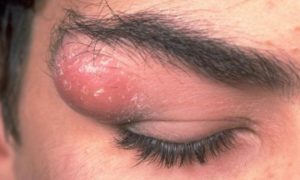
You need to see your health care provider to make sure the white pimple on your face are as a result of milia and not an underlying disease or illness. You may have trouble completely getting the cyst out of the pimple, this is because the process may be too painful.
Painful cyst on forehead under skin causing headache
A painful cyst on forehead under the skin surface causing headache is a clear indication of infection. Epidermoid cyst are the one commonly found on the face, the genitals, chest, and around skin of the genitals. Cysts are generally harmless. If you have cyst that is small and not causing any discomfort, you can leave it alone. You may find to helpful to warm compress a cyst to make it heal faster and reduce inflammation if any.
Do not be tempted to pop a cyst on the face. If it gets infected, you risk spreading the infection. An inflammation of the cyst causes it to turn red and extremely painful such that you may end up having headache.
How to remove a cyst on forehead
The best way to heal and get rid of cyst on forehead is identifying the underlying cause. After you have visited your health care provider, some test will be carried out and the cause of the pimple like bumps will be established. When this is done, the doctor will prescribe the most appropriate treatment procedure or medicine to remove the cyst.
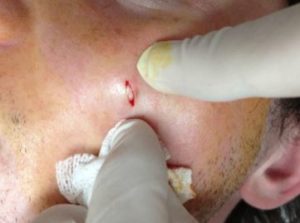
You need to visit a health care provide who will examine the cyst and prescribe the best treatment option. The medication may include face creams, gel and at times oral tablets. Which will be helpful in getting rid of the cyst on forehead and reduce the irritation. Here’s how you can remove a cyst on forehead.
Draining the cyst with warm compress
- A sebaceous on forehead can be treated by draining through warm compressing.
- Press gently but firm a washcloth immersed in water
- Leave it for about 5 minutes
- Do this procedure two to three times a day for several days
Do NOT pop a cyst on forehead.
An infected or inflamed cyst can be removed by a doctor through a safe surgical procedure. The cyst will be incised to drain the content including pus and other fluids. An injection containing steroids will be administered to reduce swelling and inflammation. Oral antibiotics will be prescribed to get rid of infection.
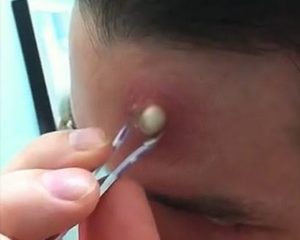
Cyst on forehead won’t go away
I have hade white pimple like lumps on my forehead for a week now, the spots are tender to touch and itchy and irritating. I have been using anti-inflammatory creams but the lumps keep getting bigger and do not go away. What do need to do to get rid of them?
If you have tried over the counter creams and antibiotics, or have been using simple home remedies to get rid of cyst on forehead but things seems not to be working out for you, you need to visit a health care provider, more specifically a dermatologist. This means you have been treating the symptom and not the underlying cause of the cyst.
The dermatologist will run test on you to establish what the actual cause of the sebaceous cyst on forehead are, then be able to prescribe the best treatment of the underlying cause, when this is done, the cyst will go away after sometime and your face will be back to normal.
You should note that treating the cause of the cyst on forehead is the best way of getting rid of the cyst. You should thus avoid self-diagnosing yourself at home. You need to see a doctor as soon as your forehead develops the cyst that fail to go away after a week.
White cyst on forehead getting bigger
Many a times, most if not all skin condition are considered harmless, however if the sebaceous cyst on face do not go away on their own, it becomes a visible sign of an underlying health complication. When this happens you need to see your dermatologist as soon as possible, so that the infection causing the cyst can be treated.
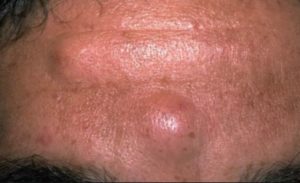
You should know that cyst on forehead are formed when sebum which oils the hair follicles get trapped and start to accumulate underneath the skin, as the sebum continues to accumulate, the bigger the cyst keep getting. You could try popping the cyst but this is not the most effective way of getting rid of them, this could lead to you getting infected with germs and bacteria.
How to get rid of a cyst on forehead with natural remedies
Most skin condition are considered harmless, the symptoms will disappear on their own after a week or two. Otherwise, you could use same simple home remedies to ease the irritation and speed the healing process. Try the following:
Oatmeal
Oatmeal has strong anti-inflammatory qualities. It can be a very good choice in alleviating skin irritation and reducing the inflammation of the cyst. To prepare the remedy do the following:
- grind raw oatmeal in a blender,
- Combine one-half cup of oatmeal, a quarter cup of milk powder and two tea spoon of honey.
- Put this mixture in a muslin cloth, tie and place it in a bath tab filled with warm water.
- Soak in the milky bath water for 20 minutes.
- Pat dry and moisturize your skin, repeat daily for a few days.
Baking soda
Baking soda may be helpful in drying the blisters that results from ruptured sebaceous cyst on forehead. It can also be helpful in reducing the itching and reducing the inflammation of the cyst.
To make the remedy, you need a tea spoon of baking soda and a cup of water. Mix them together in a cup and apply the mixture on the cyst, leave it for 10 min before rinsing it off. Repeat this daily for a week for optimal results.
Olive oil
Olive oil is rich in antibiotic qualities. When applied on face whit sebaceous cyst, it will help relieve the irritation and itching caused by the cyst. For better results, you could try a mixture of olive oil and honey. Simply rub the mixture on the affected area on face and wait for 20 min before rinsing it off, do this daily for a week and the cyst will long be gone.
Aloe Vera
For long time now aloe Vera has been used by many communities for skin related condition. Aloe Vera has anti-inflammatory, emollient, antibacterial and antifungal properties. This makes it good in treating a number of skin ailments including rashes, chicken pox spots, white sports on face, cyst on forehead and pimples. Apart from healing, it also soothes the skin, relieves itching and reduce redness.to make the remedy:
- Extract fresh Aloe Vera gel from an aloe leaf.
- Apply it on the affected area.
- Leave it on for at least 20 minutes, and then rinse it off.
- Do this at least three times a day until the rash clears.
Apple cider vinegar
The other simple and easily available remedy is apple cider vinegar. Raw and organic apple cider vinegar is good for treat skin rashes and cyst on forehead. It also helps calm the itching. Acetic acid in apple cider vinegar is also helpful in preventing skin infection. To apply on face;
- Dip a cotton ball in apple cider vinegar and place it on the affected area.
- Leave it on for a few minutes, and then remove the cotton ball.
- Do this several times a day for a few days or until your rash clears.
Turmeric
Turmeric is an excellent skin treatment agent. It is very effective in treating vitiligo. Turmeric has antibacterial properties that may be helpful in getting rid of the cyst.
- Mix some turmeric powder and a few drops of mustard oil to form a paste.
- Apply this paste over the white patchesonce in the morning and evening on a daily basis.
Eggs whites
Egg white also known as Albumen or glair. It is formed from the layer of secretions of the anterior section of the hens’ oviduct during the passage of the egg.
Egg white contain a lot of nutrients beneficial to the skin. They contain riboflavin effective in making sure the skin gets enough proteins that will help get rid of cyst on forehead.
Cyst Removal from Forehead-Video
Sources and references
- Cyst on forehead http://www.skincareorg.com/cysts/cyst-on-forehead-get-rid-cyst-forehead/
- Cyst on face treatment http://www.mayoclinic.org/diseases-conditions/sebaceous-cysts/basics/definition/con-20031599
- Cyst on face how get rid http://www.myhealthtips.in/2013/09/how-to-get-rid-of-white-patches-on-skin.html
- Cysts, Lumps and Bumps: http://www.webmd.com/skin-problems-and-treatments/guide/cysts-lumps-bumps
- Skin Cysts:http://www.nhs.uk/conditions/skin-cyst/Pages/Introduction.aspx
- Epidermoid and Pilar Cysts: http://patient.info/doctor/epidermoid-and-pilar-cysts-sebaceous-cysts-pro

